
Atlas F1 Technical Writer
The French Grand Prix saw most teams introducing notable technical updates to their cars, and in McLaren's case a completely revised machine. Atlas F1's Craig Scarborough analyses the changes seen during last weekend's race and reviews the cars' performance
The lack of running on Friday mixed up the order on both Friday and Saturday as the teams recovered lost time. The eventual victory was not a surprise bearing in mind Ferrari's form this year, however the mix of little Friday running and the circuits idiosyncrasies made for a closer race. This somewhat clouds the renaissance of teams like McLaren and Renault, whose upturn in form isn't necessarily a permanent one.
The French circuit's layout provides only one real overtaking opportunity into the slow hairpin, while drivers are challenged by some of the higher speed turns and the Imola Chicane. Equally the kerbs at the last chicane on to the start-finish straight are critical in getting a fast lap in, and qualifying proved how hard some teams were able to attack them.
Magny-Cours is unusual in that its track surface is totally smooth, there a no bumps and there is none of the usual coarseness in the tarmac. This provides problems for the tyre and race car engineers, but the flat surface allows teams to run very low ground clearances in order to gain more downforce from the diffuser without fear of grounding or wear to the skid block.
The surface's smooth texture doesn't wear the tyres down like an abrasive track like Barcelona, but it does allow the tyres to slide; this creates excessive heat and degrades the tyre compound prematurely, and the hot weather that welcomed the race on Sunday only added to the teams problems of heat induced blistering. This problem can be countered at the rear somewhat by careful tuning of the traction controls longitudinal and lateral settings, however the front wheels are down to the drivers care in braking and understeer in slower corners.
Revised Williams
Starting at the front, the unusual tusk-mounted front wing and short nose have required a pair of flow conditioners mounted above the front suspension; these inverted wings with small endplates are not there to create their own downforce but to redirect airflow downstream to another aerodynamic device more efficiently. Judging by the placement and shape of these 'wings' and their endplates, I would deduce that the flow passing over the nose in between the tusks was trying to spill over to the sides of the chassis; these 'wings' point it towards the new sidepods.
The sidepods are a major departure for Williams in concept, discarding their usual boxy shape for flowing curves, starting with Ferrari-esque undercuts and leading to a low slim coke-bottle shape at the rear. The low height of the rear deck is apparent from the shape of the new single large flip-up (replacing two stacked flip ups). The floor mounted flip up remains, following modern F1 practice to get all the flow from under the nose passed low around the sidepods and contained under the flip up, so as not to disturb the flow heading towards the rear wing.
All this development upstream helps the new rear wing, taking design hints from Toyota and Minardi. The endplates feature two curved slots allowing flow from the front wing to pass outside, resulting in a high pressure jet which meets the wing tip and reduces drag. The vertical slot copies Minardi, and allows the wake of the wing to form earlier than with a closed endplate (the endplates were enlarged for 2004).
With the unusual weekend, and Marc Gene's last minute appearance, the changes were hard to quantify; after more testing and a more routine weekend at Silverstone the developments will be able to show their true potential.
McLaren's Revised Car Debuts
That success not withstanding, the team's bugbear of cooling has yet to be fully cured. It appears that the tight sidepod shapes created for the external aerodynamics still cannot keep its internals cool enough. The newly laid out slanted radiator package has as many as six routes out of each sidepod, two of which are temporary cut outs around the exhaust ducts. Additionally the sidepods appear to be cutback around the rear suspension.
Also the car has appeared with McLaren's own take on the Ferrari donut shaped outer brake duct, with McLaren preferring to use a flat plate outboard of the brake disc in order to smooth the flow out of the wheel. In testing McLaren have also tested grooved brake discs, with 22 radial slots machined into the face of a conventionally ventilated carbon disc.
New Bell Helmet
Bell are one of the most historic helmet manufacturers, popularising the full face helmet in the seventies with the classic Bell Star and the XFM1 in the eighties. Broadly speaking the Bell design has not altered much since the eighties in terms of shape and visor system; a few aerodynamic updates with spoilers and air vents have been added, but it has been the construction of the helmet that has seen the largest development. At recent races Bell have introduced a new helmet with a totally new integrated approach to its design.
Team by Team
Ferrari
The team again appeared without any major updates to the cars, aside from a return to the higher downforce wing package. As rain affected the latter part of Friday's sessions the fastest times posted early on Friday were irrelevant. Rubens Barrichello had a hydraulic problem in Saturday that lost him both free practice and his Q1 run, while the entire system was changed, resulting in the tenth spot on the grid; Michael Schumacher's Q2 lap was up on Fernando Alonso's time until a slow third sector pushed him back to second.
With both drivers caught behind their rivals on the grid it was fortunate that both cars made good starts; Schumacher's car in particular displayed the Bridgestone tendency to take a few laps to bed in and close the gaps to the lead. Ferrari were surprise early stoppers, coming in three laps before the Renaults; with few on-track overtaking opportunities Schumacher switched to a four stop strategy, which was a pre-planned contingency for getting stuck behind another car.
In the course of the strategy change Schumacher had to push hard on new tyres, and this resulted in the set degrading more than the others, losing Schumacher time ahead of is third stop but gaining the lead. Otherwise the Bridgestones tended to grip well up to the end of the stints. Barrichello race was largely won from pit stops, while his manoeuvre on Jarno Trulli at the last lap was also a result of the Bridgestone's superior grip at the end of a stint.
Williams
Time to learn the new car on Friday was lost with both the rain and a large accident for Juan Pablo Montoya, who spun off the track, flew across the gravel and rear-ended the barriers quite heavily. Progress was made on Saturday, with Montoya posting the fastest time in Q1, but both drivers struggled in sector 3 and in particular the Imola chicane. At least the revised chassis appears to be fast enough on light tanks.
With Montoya starting to feel the effects of his Friday crash with neck and back pains, the Williams race weekend didn't improve either. Marc Gene's clutch problems forced him to make a cautious start, costing him places he was unable to recover. Montoya's race was hindered by both the pain and a lack of grip, forcing one spin off the kerbs and some lurid moments in the higher speed corners. His eventual point was hard earned, but not the true potential of the package.
McLaren
As with Williams, rain on Friday limited the teams running of the new car, but all went smoothly regardless. Saturday saw David Coulthard's smooth lap post third spot, while Kimi Raikkonen overdrove his lap from the first corner and never recovered the time.
In a reversal of their qualifying fortunes Raikkonen gained two placed with a well executed start and Coulthard lost two places. The new car raced reliably and, although not a par with the other leading teams, showed a clear improvement to bring home sixth and seventh places.
Renault
Friday went without problems and Saturday saw the cars on the pace; qualifying saw Trulli's lap slowed by some errors and wayward handling, while Alonso showed the car wasn't perfect but he was able to force a pole winning lap out of the chassis.
Both drivers made starts as good as their rivals and while Alonso was able to lap quickly, Trulli soon struggled with nervous handling and fading tyres. The team were unable to respond to the Ferrari strategy switch, leaving Alonso outside of pit stop windows on over-worn tyres, losing himself time to Schumacher in the process. With Trulli's last lap position loss, the team were consoled by reliable second and fourth positions, a better result than recent races have provided.
BAR
While other teams bring their developments in a race earlier than usual, BAR are waiting on the British race to debut their new aero packages, most likely to consist of new undercut sidepods and slimmer cooling outlets allied to revised bargeboards.
A problem free Friday but restricted track time sent the drivers into qualifying with a less than perfect set up; Jenson Button's lap was tidier than Takuma Sato's, and the small difference in lap time cost Sato three places.
After a reliability respite in Indy, Sato's engine failed with a trail of smoke early in the race, leaving Honda promising yet more action to resolve the driver specific problem. Button's potential in the race was stymied by his rivals better grid positions and starts; pit strategies worked in their favour until Button's engine bogged down at his last stop, costing him time.
Sauber
After Giancarlo Fisichella suffered a suspension failure in the morning session from the kerbs in the last chicane the resulting qualifying places on heavy fuel were to be expected. The pushrod failure led the team to replace the fasteners on the suspension in parc ferme, with the FIA's permission.
In the race Fisichella switched to a three stop strategy over the planned two stops (which Felipe Massa kept to). Rear tyre wear was the main problem, as the Bridgestone's were degrading faster than the strategy expected.
Jaguar
Only minor developments around the car, and some Cosworth engine developments, were declared for France. Now both cars have the latest spec Cosworth engine, after Mark Webber had exclusive use of it in the US due to a lack of parts for an extended supply to Christian Klien.
On finding the car balanced but not pushing the leading teams, the qualifying positions of twelfth and thirteenth reflected their heavy fuel load rather than raw pace. Continuing the conservative theme, both drivers raced well and competitively with the midfield, avoiding incidents and reliability problems to finish just out of the points.
Toyota
No visual changes were apparent on the Toyota, as the revised lightweight chassis is due for Germany. Qualifying runs saw a clean lap for Cristiano da Matta, and handling problems from bottoming and fading tyres cost Olivier Panis time on his lap.
Panis' troublesome home-race weekend worsened when his clutch stuck at the start, leaving him limping off the line and falling behind the entire field. That notwithstanding both cars lacked the pace and grip to pressure their rivals, finishing well down the order.
Jordan
Instead of new parts for the car, the team used lessons learnt in the cars set up from straight line testing to make progress this weekend. Driver errors kept the Jordan's in their usual ninth row on the grid. The race repeated the pattern, and Nick Heidfeld's better pace was handicapped by a poor start and misread pit stop instruction, leading him to drive thorough the pits unnecessarily.
Minardi
Magny-Cours, in a lot of respects, is another modern featureless circuit, but it does have its own unique characteristics - it requires moderately high downforce, and its surface punishes tyres. This year's wet Friday sessions put pressure on teams trying to select their tyres, and even more stress for the two teams, Williams and McLaren, which were contesting highly modified cars.
 Introduced before the usual Silverstone race, Williams presented their car with a major update to its aerodynamics. In concept, the update takes several cues from cars around the rest of the grid, from Ferrari all the way back to Toyota and Minardi. As expected the update was largely aimed at the rear of the car to reduce drag, increase downforce and stability, and to balance that at the front.
Introduced before the usual Silverstone race, Williams presented their car with a major update to its aerodynamics. In concept, the update takes several cues from cars around the rest of the grid, from Ferrari all the way back to Toyota and Minardi. As expected the update was largely aimed at the rear of the car to reduce drag, increase downforce and stability, and to balance that at the front.
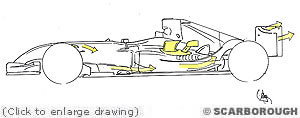 The detail of the sidepods has also changed, with the chimney and winglets now affixed to a detachable panel and the cooling grills, unusually, permanently moulded into the sidepod itself. This allows Williams to have a permanent cooling outlet (the grills), as well as the option to quickly change the chimney/winglet arrangement while setting up the car.
The detail of the sidepods has also changed, with the chimney and winglets now affixed to a detachable panel and the cooling grills, unusually, permanently moulded into the sidepod itself. This allows Williams to have a permanent cooling outlet (the grills), as well as the option to quickly change the chimney/winglet arrangement while setting up the car.
 After several successful test appearances the new McLaren MP4-19B made its race debut in France. Largely unchanged from its first appearance, the car's improved pace was immediately apparent, with the new sidepods, engine and rear suspension all working more effectively.
After several successful test appearances the new McLaren MP4-19B made its race debut in France. Largely unchanged from its first appearance, the car's improved pace was immediately apparent, with the new sidepods, engine and rear suspension all working more effectively.
 Although primarily a safety device, the modern crash helmet is also an aerodynamically critical part of the car. Its shape affects both driver comfort and the efficiency of the engines air inlet snorkel. The airflow around the shell and visor produce buffeting lift and noise; this all affects the drivers' performance at high speed. The problem of reducing lift has been addressed by the attachment of plastic spoilers to the chin bar and rear, although the sealing and shape of the visor has remained an issue, as it needs to pivot open.
Although primarily a safety device, the modern crash helmet is also an aerodynamically critical part of the car. Its shape affects both driver comfort and the efficiency of the engines air inlet snorkel. The airflow around the shell and visor produce buffeting lift and noise; this all affects the drivers' performance at high speed. The problem of reducing lift has been addressed by the attachment of plastic spoilers to the chin bar and rear, although the sealing and shape of the visor has remained an issue, as it needs to pivot open.
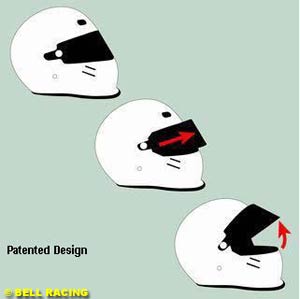 Their new helmet provides a completely smooth exterior, including a novel flush fitting visor. In order to recess the visor around all four edges, the pivot now moves forward to push the visor out of the recess to open. This reduced noise and drag, making both the driver and the aerodynamicists happier.
Their new helmet provides a completely smooth exterior, including a novel flush fitting visor. In order to recess the visor around all four edges, the pivot now moves forward to push the visor out of the recess to open. This reduced noise and drag, making both the driver and the aerodynamicists happier.
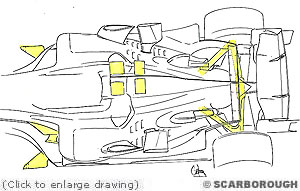 Another innovation at Renault has been the adoption of a one piece upper wishbone at the rear. One piece wishbones have been used at the front on single keel cars for sometime; the close proximity of the inboard ends of the wishbones allows for a stiffer set up if the loads are passed through a single part rather than being bolted on as separate parts. As most teams place the rear leg of the rear wishbone high up on the rear crash structure, an advantage in stiffness can also be gained from making a single component.
Another innovation at Renault has been the adoption of a one piece upper wishbone at the rear. One piece wishbones have been used at the front on single keel cars for sometime; the close proximity of the inboard ends of the wishbones allows for a stiffer set up if the loads are passed through a single part rather than being bolted on as separate parts. As most teams place the rear leg of the rear wishbone high up on the rear crash structure, an advantage in stiffness can also be gained from making a single component.
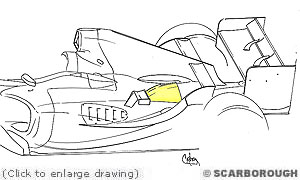 A number of small detail changes were applied to the Saubers in France; including a new front wing as well as Ferrari 2003 style exhaust fairings, with an extension to the outboard side.
A number of small detail changes were applied to the Saubers in France; including a new front wing as well as Ferrari 2003 style exhaust fairings, with an extension to the outboard side.
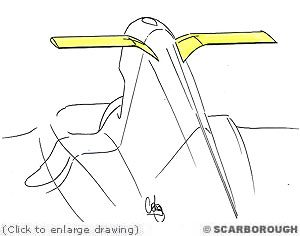 Continuing Minardi's unusually high pace of aero development, a new mid wing was used in France. The wing, revised from the version briefly tried in Monaco, is mounted to the engine cover and forms a V at its mounting points. In qualifying and the race the cars trail the field as usual, Zsolt Baumgartner being one of only two retirements when he spun and got stuck in the gravel, while Gianmaria Bruni was almost the third retirement when his gearbox started leaking towards the end of the race; he was able to complete the race distance, albeit pitting on the last lap to prevent a total gearbox failure.
Continuing Minardi's unusually high pace of aero development, a new mid wing was used in France. The wing, revised from the version briefly tried in Monaco, is mounted to the engine cover and forms a V at its mounting points. In qualifying and the race the cars trail the field as usual, Zsolt Baumgartner being one of only two retirements when he spun and got stuck in the gravel, while Gianmaria Bruni was almost the third retirement when his gearbox started leaking towards the end of the race; he was able to complete the race distance, albeit pitting on the last lap to prevent a total gearbox failure.
|
Contact the Author Contact the Editor |
Please Contact Us for permission to republish this or any other material from Atlas F1.